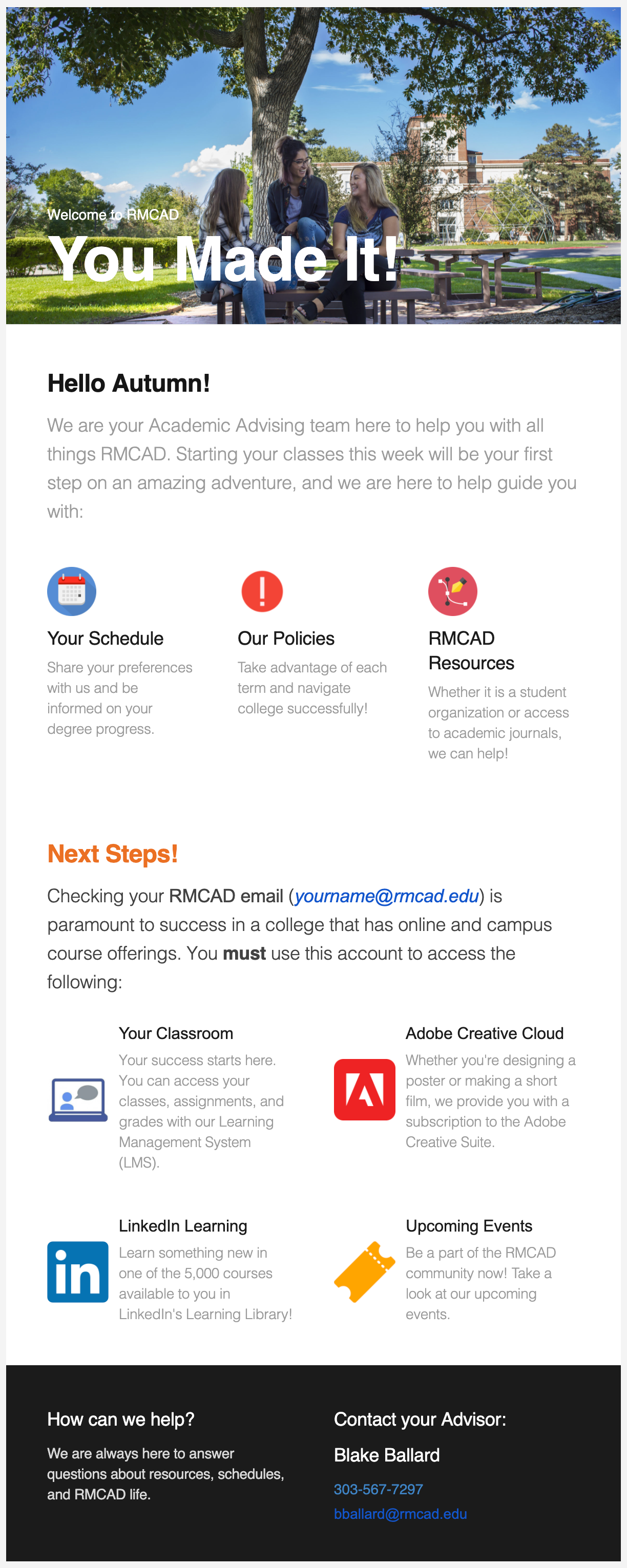The Effect of Rich Email Communication by Academic Advising on Student Retention and Engagement with Academic Information
Action Research Project
Proactive student engagement in academic advising should be thoughtful, intentional, and informed by data. This action research project aims to do just that.
Target audience: Student Affairs Departments; Higher Education Leadership; Academic Advising departments
Tools used: HTML5, CSS, GMass, Excel, Academic Databases
Year: 2021-2022
Overview
There is a growing need for student support services to adjust communication techniques to better suit the new student populations enrolling in undergraduate programs in the United States. Previous research suggests that Academic Advising and other support services are necessary in creating a sense of belonging, increase retention rates, and foster student success (Center for Community College Student Engagement, 2018) (Upcraft, 1995). This action research project discusses the impact of using rich email communication, using HTML5 and CSS styling, in new student welcome emails.
EMDT Program Learning Goal(s):
Students will evaluate and create instructional media and technology to support teaching and learning.
Students will identify and critically examine educational technology trends for practical application.
Students will participate in and contribute to communities of practice and professional networks.
Students will effectively communicate educational technology trends to stakeholders, grounding their findings in research.
Instructional Goal of the Artifact:
Communicate Action Research Project findings in an academic and research-centric modality.
Process
Literature Review
At the halfway mark in the EMDT program we were required to establish a plan for an action research project connecting technology to our current student population. To begin this process, we established our guiding research questions and put together a literature review.
My proposed goal of this study was to determine the effect of using HTML5 emails on student retention and knowledge of academic policies with undergraduate students in their first semester. I also wanted to discuss how new students use email communication to become more informed about institutional expectations and what type of media preferences do new students have in 2021 and how does it impact prior advising practices? With these questions to guide my action research project, I then compiled sources for a literature review.
This literature review is a compilation of the research on a particular topic meant to establish the need for a particular study and to connect that study to the existing body of knowledge on a topic. After compiling peer-reviewed and other academic sources, I divided my research into four sections to better organize my review: Retention in Higher Education, Technology Usage in Student Services, Academic Advising Practices, and Rationale for Further Research.
After the literature review was complete, we were encouraged to share the action research project with stakeholders through a formal presentation. This presentation includes the research questions, context for the study, and impact on our chosen participants.
Stakeholder Presentation
Conducting the Research
For the Fall Semester of 2021, I redesigned the Academic Advising welcome email that is sent to all new students at RMCAD in hopes in improving knowledge of institutional expectations/policies and increase retention. Starting with the previous template, I built a richer email using HTML5 and CSS. This revised email template included more imagery, bolder graphics, highlighted advisor contact information, and provided next steps for students. This new template was also mobile responsive.
Original Email Template
New Email Template
For this study, new students starting in the Fall 2021 semester were chosen to be participants. The RMCAD Institutional Review Board (IRB) application was submitted before the study was undertaken; however, no personal information was collected and shared, so no informed consent documents were needed.
RMCAD’s academic semester is divided into two terms (A term and B term) which allowed for two opportunities to collect data. The Fall A 2021 term had 407 new students and Fall B 2021 had 127 new students, each receiving an individual welcome email. With the large population starting in Fall A, A/B testing of the subject was incorporated into the study. A/B testing compares two versions of something to determine differences in performance (Gallo, 2017).
GMass, a mail merge and mass email plug-in for Gmail, was used to randomly send the participant list either the A or B subject line. This plug-in was also used to personalize each email with the student name and specific advisor contact information. For the smaller number of Fall B participants, the Subject B line was chosen due to slightly better performance in open and click-through rate
Compiling Results
Full results can be viewed in the final report below, but data was collected from two email campaigns for the Fall 2021 semester at RMCAD. Participants in the study included new students for the Fall A and Fall B 2021 terms. In total, 534 emails were sent and data was collected from the outcomes of those emails. Key points of interest include the number of students who opened the email and engaged with the content (click-through rate, replies, and browser type).
Final Action Research Project Report
Results and Takeaways
By understanding student preferences and actions, support staff can cater their tactics to best fit the needs and wants of a new-start cohort. This study reviewed the impact of changes made to the new student welcome email using HTML5, discovered the improvement between national averages for open and click through rate, and discussed the content that was engaged with most. Students in this study had high engagement rates with the welcome email sent by the Academic Advising team; however, retention rates were similar to the 2021 national average. This showcases that one email alone cannot change the trajectory of a student’s experience, but it can help advisors and other support staff understand the needs of new students moving forward.
While new students start each year, they bring a different set of preferences that must be accommodated. With the COVID-19 pandemic impacting the way new students operate, higher education staff have a challenge to prepare, support, and engage with new-start students, no matter the year or circumstance.
Action Research projects have the opportunity for educators to implement changes and discuss the outcome, for both positive and negative results. Research informed education practices have become the norm for so many educational programs and training, but the action research project modality gives agency to educators to build their own results and contribute to communities of practice.
“Data driven, rigor, closing the gap, and evidence based are just a few terms that have taken added importance in an era where teachers are increasingly held accountable for ensuring students meet specific educational outcomes while in their classroom.”
References
Center for Community College Student Engagement. (2018). (rep.). Show Me the Way: The Power of Advising in Community Colleges.
Gallo, A. (2017, November 27). A refresher on a/B testing. Harvard Business Review. Retrieved March 20, 2022, from https://hbr.org/2017/06/a-refresher-on-ab-testing
Putman, S. M., & Rock, T. (2017). Action research: Using strategic inquiry to improve teaching and learning. Sage Publications.
Upcraft, L. M. (1995). Insights from theory: Understanding first-year student development. First-Year Academic Advising: Patterns in the Present, Pathways to the Future, 18, 15-24.Columbia , SC: University of South Carolina, The National Resource Center for The First-Year Experience and Students in Transition.




